| Plugin Name | CatFolders |
|---|---|
| Type of Vulnerability | SQL Injection |
| CVE Number | CVE-2025-9776 |
| Urgency | Low |
| CVE Publish Date | 2025-09-11 |
| Source URL | CVE-2025-9776 |
CatFolders SQL Injection (CVE-2025-9776) — Quick Technical Briefing
By: Hong Kong Security Expert — concise advisory for site owners and developers. Purpose: explain risk, detection signals and practical mitigations without disclosing exploit details.
Summary
The CatFolders WordPress plugin has been assigned CVE-2025-9776 for a SQL injection vulnerability. While classified with low urgency, the issue can allow an attacker to influence database queries under certain conditions. Site owners should treat this seriously because any injection flaw can lead to data exposure, privilege escalation or site integrity issues depending on the environment and attacker access.
Technical Impact (High-level)
SQL injection vulnerabilities enable untrusted input to modify the intended structure of database queries. Consequences vary by context and may include:
- Unauthorized reading of database content (e.g., user records, configuration)
- Modification or deletion of stored data
- Potential for chained attacks that escalate access or persist backdoors
Severity depends on the database privileges of the web application account and the specific queries affected. The “low” urgency here indicates limited exploitability or confined impact compared to critical injection flaws, but mitigation is still recommended.
Who Is Affected
Any WordPress site running the impacted versions of the CatFolders plugin is potentially at risk. Administrators should check the plugin details and the vendor’s changelog or security advisory to determine whether their installed version is listed as vulnerable and whether a fixed release is available.
Detection & Indicators
Look for the following signs during routine checks and incident triage (these are detection hints, not exploit instructions):
- Unexpected or suspicious entries in access logs targeting plugin endpoints or parameters.
- Errors in application logs indicating database query failures or malformed queries.
- Unexplained changes to site content, user records or configuration stored in the database.
- Presence of unknown admin users or modified plugin files (verify against a clean copy).
Mitigation Steps (Practical and Safe)
Follow a layered approach: contain, remediate, then harden.
- Patch or update: Apply the vendor-provided fix as soon as it is available. Confirm the update from the official plugin page or repository before installing.
- Temporary containment: If a patch is not yet available, consider deactivating the plugin until a safe update can be applied. If the plugin is critical, isolate the affected functionality where possible.
- Restrict database privileges: Ensure the WordPress database user has the minimum required privileges. Avoid running the site with a database account that has unnecessary administrative rights.
- Verify integrity and recover: Scan for unknown admin accounts, altered files, or database changes. If compromise is detected, restore from a verified clean backup and rotate credentials.
- Harden inputs in custom code: Developers should use parameterized queries (prepared statements) and proper input validation when interacting with the database. This reduces exposure to injection issues in custom integrations.
- Monitor: Increase logging and monitoring around the plugin’s endpoints and database errors during the remediation window.
Developer Notes
For plugin authors and integrators: review all code paths that accept user-controlled input and interact with the database. Use parameterized queries, sanitize and validate inputs, and apply defensive coding practices. Consider adding unit and integration tests that simulate malformed input to prevent regressions.
Disclosure & References
Official CVE record: CVE-2025-9776. Check the plugin’s official page or repository for vendor advisories and the fixed release notes.
